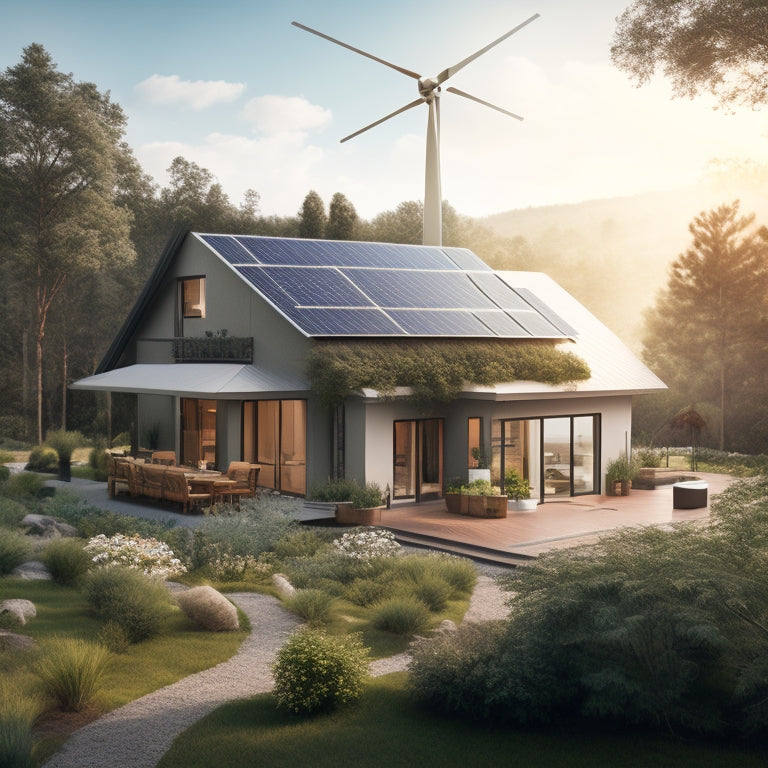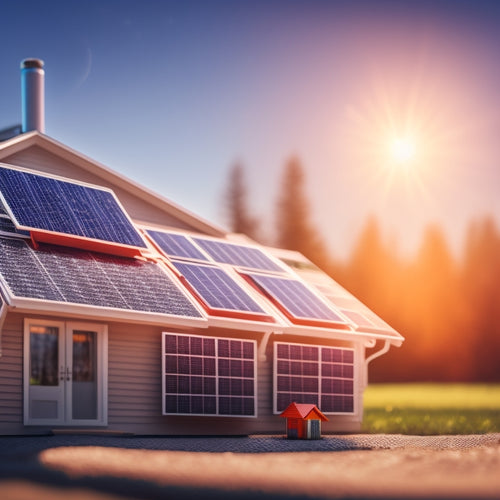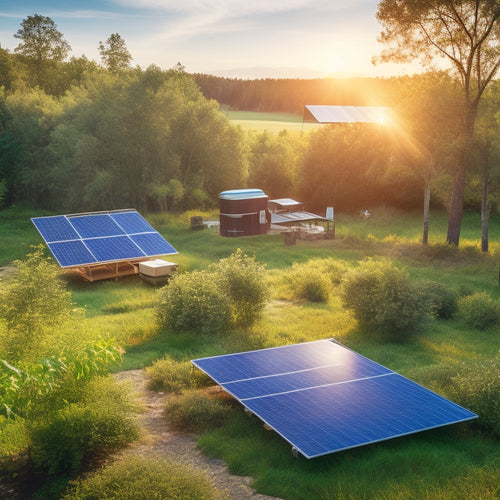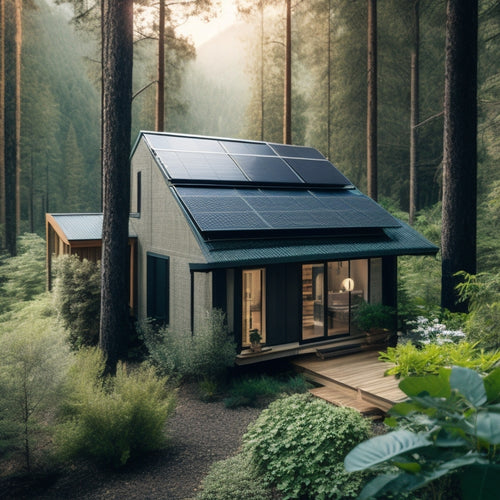
What Makes Off-Grid Homes Self Sufficient?
Share
You achieve self-sufficiency in off-grid homes by integrating renewable energy generation, efficient water collection and conservation systems, waste management strategies, and local food production methods. Renewable energy sources like solar power, with reliable energy storage systems, provide a steady supply of electricity. Efficient water collection systems, such as rainwater harvesting, reduce reliance on municipal water supplies. Waste management strategies, including composting toilets and greywater recycling, minimize waste and optimize resource utilization. Finally, local food production methods, like companion planting, reduce your carbon footprint. You'll find that by combining these elements, you'll be well on your way to creating a self-sufficient off-grid home that's customized to your unique needs.
Key Takeaways
- Off-grid homes rely on renewable energy sources like solar power, which provides a reliable and efficient means of generating electricity.
- Energy storage systems, including battery banks and inverters, are crucial for storing excess energy and providing power during periods of low energy generation.
- Rainwater harvesting and conservation systems enable off-grid homes to collect, store, and efficiently use rainwater, reducing reliance on municipal water supplies.
- Implementing energy-efficient appliances and systems, such as low-flow fixtures and natural ventilation, minimizes energy consumption and promotes self-sufficiency.
- Proper planning, design, and maintenance of off-grid systems ensure a reliable and efficient supply of energy and water, making off-grid living possible.
Solar Power for Off-Grid Homes
One of the most critical components of off-grid homes is a reliable source of energy, and solar power is an increasingly popular choice for many homeowners.
You'll want to take into account the different solar panel types, each with its own energy efficiency benefits. Monocrystalline silicon panels, for instance, boast high efficiency rates of up to 22%, making them a top choice for off-grid homes.
Polycrystalline silicon panels, on the other hand, offer slightly lower efficiency rates but are more budget-friendly. Thin-film panels provide a cheaper alternative, albeit with lower efficiency rates.
When selecting a solar panel type, you'll need to balance energy efficiency with cost and space constraints to provide a reliable source of energy for your off-grid home.
High-efficiency solar panels, such as those with a 20% efficiency rate, can optimize energy production, and systems designed to withstand harsh weather conditions guarantee long-lasting performance and reliability.
Energy Storage Systems Design
You'll need to carefully plan your energy storage system to guarantee it can handle your off-grid home's power needs. This involves designing a battery bank configuration that can store excess energy generated by your solar panels, sizing the system to meet your specific energy requirements, and selecting an inverter that can efficiently convert DC power to AC.
When it comes to selecting the right components, consider factors such as reliable inverters and high-capacity batteries to assure a reliable and efficient energy supply.
Additionally, regular maintenance, such as cleaning your solar panels every 6-12 months, is vital to maintain peak performance. By getting these essential components right, you'll be able to maintain a reliable and efficient energy supply.
Battery Bank Configuration
Designing an efficient battery bank configuration is a vital step in creating a reliable energy storage system for your off-grid home, as it enables you to store excess energy generated by your renewable sources and draw on it when needed.
When configuring your battery bank, consider the following key factors:
-
Battery Capacity: Confirm you have sufficient capacity to meet your energy demands during periods of low renewable energy generation.
-
Battery Types: Choose the right type of battery for your system, such as lead-acid, lithium-ion, or saltwater batteries, each with their own characteristics and benefits.
-
Battery Maintenance: Regular maintenance is essential to extend battery longevity, including monitoring state of charge, voltage, and temperature.
- Battery Safety: Implement safety measures to prevent overcharging, overheating, and electrical shock, confirming a safe and reliable operation.
System Sizing Considerations
At least 25% of your off-grid home's energy storage system design relies on accurate system sizing considerations, ensuring your energy storage capacity meets your specific needs.
When designing your energy storage system, you'll need to perform load calculations to determine your daily energy requirements. This involves accounting for the energy efficiency of your appliances, lighting, and other electrical loads.
By accurately sizing your system, you'll avoid oversizing, which can lead to wasted resources and increased costs. Conversely, undersizing can result in inadequate power supply, compromising your off-grid lifestyle.
Inverter Selection Criteria
With your energy storage system's load calculations complete, it's time to focus on the inverter, a critical component that converts DC power from your batteries to AC power for your off-grid home.
When selecting an inverter, consider the following key criteria:
-
Inverter types: Choose from string inverters, microinverters, or power optimizers, each with its pros and cons. String inverters are cost-effective but may not perform well with partial shading, while microinverters offer maximum flexibility but are more expensive.
-
Inverter efficiency: Opt for an inverter with a high efficiency rating (e.g., 95% or higher) to minimize energy losses and guarantee maximum power output.
-
Power rating: Select an inverter that matches your system's maximum power output to avoid oversizing or undersizing.
- Compatibility: Verify the inverter is compatible with your battery type, charge controller, and other system components.
Efficient Water Collection Systems
You'll need to evaluate three key components when designing an efficient water collection system for your off-grid home: rainwater harvesting methods that maximize collection capacity, water storage solutions that guarantee reliability and safety, and conservation techniques that minimize waste and optimize usage.
When selecting a water pump, investigate solar, wind, or hydro power options based on energy availability off-grid water pumping needs and prioritize pumps with efficient flow rates, pressure, and power consumption.
By selecting the right combination of these elements, you can reduce your reliance on municipal water supplies and create a more self-sufficient living space.
With the right strategy, you can collect and conserve enough water to meet your daily needs, even in areas with limited rainfall.
Rainwater Harvesting Methods
Rainwater harvesting systems are an integral component of off-grid homes, providing a reliable source of water for various non-potable uses such as flushing toilets, washing clothes, and irrigating gardens.
As you design your rainwater harvesting system, it's vital to contemplate the following methods to guarantee efficient water collection:
-
Roof catchment: collecting rainwater from your rooftop through a drainage system that directs water into a storage tank.
-
Ground catchment: collecting rainwater from a surface area such as a courtyard or patio, which is then channeled into a storage tank.
-
Filtration techniques: using systems like mesh screens, first flush devices, or sedimentation tanks to remove debris and contaminants from harvested water.
- Overflow management: implementing a system to manage excess water during heavy rainfall events, such as redirecting it to a secondary storage tank or a stormwater management system.
Water Storage Solutions
Designing an efficient water collection system hinges on selecting the right water storage solutions, as these components are essential to the overall performance of your off-grid home's rainwater harvesting system.
You'll need to take into account factors like water quality, storage tank size, and filtration systems to guarantee a reliable supply. Regular maintenance practices, such as cleaning and inspecting your storage tanks, are also vital.
Effective usage planning helps you allocate water resources, ensuring drought resilience and minimizing the need for backup sources. Additionally, you may want to investigate gray water reuse and seasonal storage options.
Conservation Techniques
Efficiency is the cornerstone of a thriving off-grid lifestyle, and optimizing water collection systems is essential to achieving this goal.
You'll want to implement efficient water collection techniques to minimize waste and maximize your water storage. To do this, consider the following strategies:
-
Greywater recycling: Reuse water from sinks, showers, and washing machines for irrigation and flushing toilets.
-
Insulation techniques: Properly insulate your pipes to reduce heat loss and prevent freezing.
-
Natural ventilation: Design your home to maximize natural airflow, reducing the need for energy-intensive ventilation systems.
- Eco-friendly materials: Choose materials that are sustainable, durable, and require minimal maintenance, such as low-flow fixtures and composting toilets.
Rainwater Harvesting Benefits
Collecting and storing rainwater for later use can greatly reduce your reliance on municipal water supplies, lowering your water bills and mitigating the impact of droughts.
By implementing rooftop collection techniques, you can gather a substantial amount of rainwater. This water can then be filtered using rainwater filtration systems, making it suitable for household use.
With a properly designed system, you can harvest enough rainwater to meet your daily needs, reducing your municipal water consumption by up to 50%. This not only saves you money but also reduces the burden on local water treatment infrastructure.
Waste Management Strategies
Your off-grid home's waste management strategy is essential to achieving self-sufficiency, as it directly impacts your environmental footprint and quality of life.
Effective waste management reduces your reliance on public sewage systems and minimizes the risk of water pollution.
To achieve waste reduction, consider implementing the following strategies:
-
Composting toilets: Convert human waste into organic fertilizer, reducing water consumption and producing a beneficial resource.
-
Waste separation: Segregate biodegradable waste from non-biodegradable waste to facilitate efficient recycling and composting.
-
Greywater recycling: Reuse water from sinks, showers, and washing machines for irrigation and flushing toilets, reducing your water footprint.
- Organic waste composting: Convert food waste and yard trimmings into nutrient-rich compost, reducing waste sent to landfills and creating a natural fertilizer.
Local Food Production Methods
About 30% of the average household's carbon footprint stems from food production, processing, and transportation. By implementing local food production methods, you can greatly reduce your reliance on industrial agriculture and lower your carbon footprint.
| Method | Description |
|---|---|
| Companion Planting | Pairing plants that benefit from each other's growth, such as marigolds and tomatoes, to enhance growth and reduce pests. |
| Vertical Gardening | Maximizing space by growing plants upwards, ideal for small plots or urban areas. |
| Greenhouse Gardening | Extending the growing season by controlling temperature and light, allowing for year-round production. |
You can also investigate permaculture techniques, organic pest control, raised beds, crop rotation, seasonal planting, and heirloom seeds to create a thriving and sustainable food system. Additionally, consider joining or starting a community garden to share knowledge and resources with like-minded individuals.
Off-Grid Water Purification
Nearly 85% of the world's wastewater remains untreated, posing significant environmental and health risks.
As you consider off-grid water purification, you'll want to investigate various filtration technologies and purification methods to guarantee access to clean drinking water.
You'll have several options to choose from, including:
-
UV purification systems, which use ultraviolet light to kill bacteria and other microorganisms.
-
Ceramic water filters, which remove impurities through a ceramic element with small pores.
-
Reverse osmosis systems, which use a semi-permeable membrane to remove dissolved solids and other contaminants.
- Distillation systems, which involve boiling water and then collecting the condensed steam, free from many contaminants.
Frequently Asked Questions
Can Off-Grid Homes Be Connected to the Grid if Needed?
You can design your off-grid home to integrate with the grid if needed, incorporating backup systems like generators or battery banks, allowing you to switch between self-sufficiency and grid reliance as circumstances demand.
How Do Off-Grid Homes Handle Extreme Weather Conditions?
When you're living off-grid, you'll face extreme weather conditions, but you're prepared; you've invested in solar energy, water collection systems, thermal insulation, and emergency preparedness plans, using sustainable materials and alternative heating sources to guarantee your home remains safe and habitable.
Are Off-Grid Homes More Prone to Pest Infestations?
As you step into your off-grid home, you're surrounded by the serene sounds of nature, but you're also more likely to encounter unwelcome guests; however, with effective pest control measures and natural deterrents like citrus and mint, you'll keep those critters at bay.
Can I Finance an Off-Grid Home With a Mortgage?
You can finance an off-grid home with a mortgage, exploring specialized mortgage options like USDA or FHA loans, which offer financial incentives, such as lower interest rates or energy-efficient upgrades, to support your sustainable living goals.
Do Off-Grid Homes Have to Follow Building Codes?
Are you prepared to steer through the gray area of building codes? Typically, you'll need to comply with local building regulations, but self-sufficiency standards may vary, and some areas offer exemptions or alternative paths for off-grid homes.
Related Posts
-

A Beginner's Guide to Navigating the Solar Investment Tax Credit
You're eligible to claim a significant Solar Investment Tax Credit (ITC) of 30% of total installation costs, but mane...
-

Top Off Grid Solar Batteries for Renewable Energy
When seeking top off-grid solar batteries for renewable energy, consider options with advanced battery chemistry, suc...
-

Off Grid Solar Batteries
As you shift to off-grid living, you'll rely on high-performance solar batteries to store excess energy generated by ...


